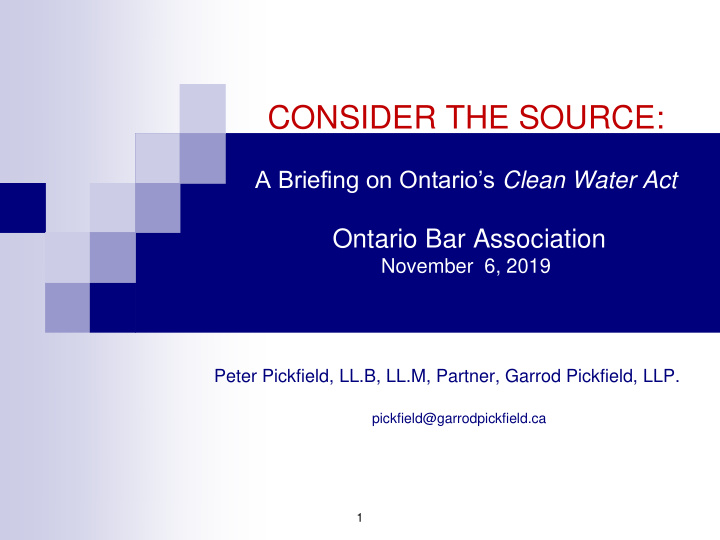



CONSIDER THE SOURCE: A Briefing on Ontario’s Clean Water Act Ontario Bar Association November 6, 2019 Peter Pickfield, LL.B, LL.M, Partner, Garrod Pickfield, LLP. pickfield@garrodpickfield.ca 1
Introduction Legacy of an Environmental Tragedy A regulatory regime to protect drinking water sources from significant threats Overview of Presentation Briefing on key components of CWA (four parts to this) Status report on implementation phase Implications for municipal and planning lawyers and their clients 2
CWA Briefing: Overview of Components Source Protection Plans 1. Implementations Mechanisms 2. Enforcement Powers 3. Appeal Rights 4. 3
CWA Briefing: 1) Source Protection Plans Source Protection Authorities 1. Assessment Reports 1. Development and Approval of SPPs 2. Key Content of SPPs 3. Identifies Drinking Water Threats Policies to address drinking water threats Mapping of Groundwater Vulnerability areas and wellhead protection areas Designations of areas/activities that are prohibited Designation of areas/activities requiring RSPs Designation of areas/restricted land uses requiring approval before development can proceed 4
CWA Briefing: 2) Implementation Mechanisms Updating Land Use Planning Policies 1. Prohibiting Activities that Threaten Drinking Water (s. 57, CWA) 2. Regulating Existing Activities – Risk Management Plans (s. 58, CWA) 3. By Agreement with RMO- s. 58 (5) By Application to RMO – s.58 (11) By Order of RMO – s. 58 (10) Restrictions on New Land Uses – s. 59 4. 5
CWA Briefing: 3) Enforcement Powers Order to Report – s. 61 1. Inspections/Investigations – s. 62 2. Enforcement Orders – s.63 3. “Causing the Thing to be Done” 4. RMO power to take action – s. 64 Order to Pay (Cost Recovery) – s. 67 6
CWA Briefing: 4) Appeal Rights No Appeal of SPPs or their amendment 1. Appeal rights for: 2. Risk Management Plans Enforcement Orders Orders to Pay Appeal to Environmental Review Tribunal (none to date) 3. 7
CWA Status Report: 1) Source Protection Plans All SPPs in Place: 25 Plans across 19 Source Protection Regions 1. First Round of SPP Amendments : 15 SPPs 2. More changes coming : Drinking Water Quantity Threats (GRSPP) 3. Tier 3 Water Budget and Risk Assessment Changes to SPP- new policies, prohibitions and RMPs to protection municipal drinking water systems from competing water demands/climate change 8
CWA Status Report: 2) Implementation Measures Updating Official Plans, zoning by-laws: process is on- going Risk Management Plans Notices issued to property owners RMOs taking collaborative approach to developing RMPs Generally by Agreement not Order Process is on-going New Planning Applications/Building Permits: Municipal Screening Procedures RMOs: protocols, procedures and forms to implement measures 9
CWA Status Report: 3) Enforcements/ Appeals Most RMOs have not yet tested investigation and enforcement powers Focus on voluntary compliance and agreement No appeals have ever been made to Environmental Review Tribunal under CWA Possible Reasons: Voluntary compliance is working Early implementation priorities Resource Limitations Haven’t reached the tough case yet 10
Implications for Clients: 1) Existing Businesses/Property owners SPP Prohibitions (s. 57) - No clear mechanism to challenge Risk Management Plans (s. 58) 120 day compliance period when notice received Triggers dialogue with RMO Task will be to developing workable of risk management measures and reach agreement with RMO Clients may need to retain experts and legal support Experience so far: RMOs have been responsive to reasonable business concerns Potential legal role in drafting agreements, risk management measures If content of RMP cannot be resolved, RMO could issue an order imposing - Trigger appeal rights. 11
Implications for Clients: 2) Developers/Clients Seeking Land Use Approvals Section 59, CWA: New set of approvals requirements applies to: Proposed land use changes for regulated activities within areas designated under SPP for protection Includes Planning Act application for regulated activity Includes Building Code applications involving a regulated activities If section 59 requirement triggered: Proponent cannot apply under Planning Act or obtain building permit until RMO issues notice allowing it to proceed RMO may require Risk Management Plan to be put in place first May require clients to obtain expertise Requires working with RMO to determine what if any risk management measures will need to be put in place 12
Implications for Clients: 3) Municipal Clients Watersheds versus political boundaries Need to consider planning decisions in multiple planning areas Need for collaboration between municipalities Advising Risk Management Officials Challenge of multiple SPPs/municipal masters Negotiating skills needed with businesses/ property owners When is enforcement action needed? Impacts on Municipal staff/resources Planning Staff – OP changes/ section 59 requirements CBOs and building departments Section 59 Requirements OBC Sewage System Mandatory Inspections Program Financial Challenges Administration and enforcement costs not covered by Province Funding options: development application fees; CWA Fee for Service; charge to water rates 13
Conclusions: Implementation has gone better than expected 1. RMOs seem to managing workload Major conflicts and legal challenges avoided Enforcement powers not required No appeals Challenges may lie ahead 2. Toughest cases involving existing businesses not get tackled Enforcement powers may be needed – triggering appeals Program expansion – water quantity threats Clients may need your help 3. Businesses faced with new source protection requirements Developers facing new restrictions new development Municipalities need legal advice and advocacy 14
Phone Number : (519) 837-0500 Email : info@garrodpickfield.ca Website : www.garrodpickfield.ca Peter Pickfield: pickfield@garrodpickfield.ca 15
Recommend
More recommend